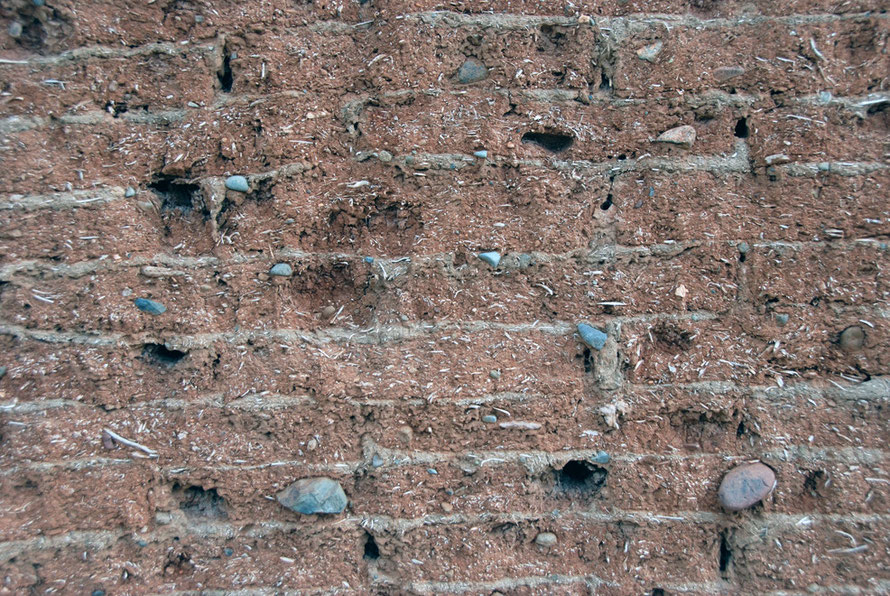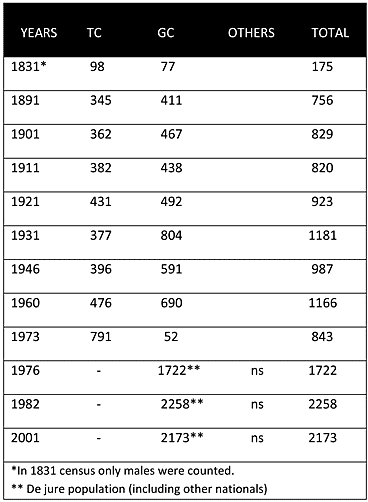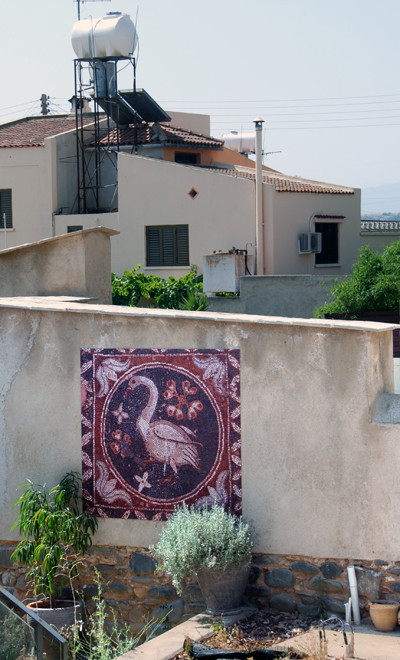Villages II: Peristerona: the story of a mixed village that is mixed no more
One of the villages I've liked the most during my brief travels in Cyprus is Peristerona.The village has a welcoming feel after the brash suburbs of Nicosia that straggle out into the Mesoria through Mammari and the dusty chaotic main drag of Kokkinotrimithia (close to where Cypriots were interned in the first wave of anti-British agitation and bombing according to Durrell in Bitter Lemons) . It also feels alive, vibrant even, compared to the locked-up villages in the high winter hills.
On the road from Nicosia it is preceded by the smaller village of Akaki, sited on another river (funnily enough called the 'Akaki') flowing down from the northern Troodos mountains. There is a series of channels that takes waters from the Akaki through the village streets which I found charming but difficult to photograph.
In the summer both the Akaki and Peristerona rivers beds are bone dry and the villages bake in the unremitting heat of the Cyprus summer.
Photographs of Akaki Village
One of the most striking features of Peristerona is the view - from the eastern approach - of the 10th century, Byzantine, five-domed St Barnabas and Hilarion church rising above the western bank of the Peristerona river and further upstream, and higher up the hill that rises from the bank, the Peristerona Mosque (as it seems to be known). This scene was featured on the Cypriot £5 note issued in 1997.
The village is also hugely improved because the busy traffic on the B9 - the main road between Nicosia and the Troodos - bypasses the centre on a modern concrete bridge built downstream.
The name Peristerona derives from the Greek word for dove or pigeon (peristeri).

Peristerona, and nearby Akaki for that matter, feel like villages where people still work the land. In parts of them little old Fordson and Massey Ferguson tractors are more common than cars. Indeed, if you shut out the heat and light you could almost be at the vintage end of an East Kent Ploughing Match (see my page on this). And not only are the tractors small and old, but so, seemingly, are the people.
The houses are generally modest, some little two-room single storey post-war affairs and others seem much older, being built with an enclosed yard out of plastered mud-brick. On the day I visited in early January many doors had an olive branch fixed to them.
The olive branches on the doors are to ward off the evil spirits, the Kallikantzari, that roam the land on the nights between Christmas Day and Epiphany Day on 6th January.
According to custom there are various ways of protecting yourself from a visit from the Kallikantzari, including hanging an olive branch outside your door, leaving a colander on your doorstep or keeping the fireplace burning through the night. Burning shoe leather can also work.
A colander left outside was believed to effective because the Kallikantzari, who only appeared at night, would stop to count the holes in the colander and they could not count beyond two, because three was a holy number - the trinity - and by naming it they would kill themselves. So the Kallikantzari would sit counting until day break when they are forced to hide from the sun (see Wikpedia).
The Kallikantzari dwell underground outside of the twelve days of Christmas, sawing away at the World Tree, which when felled would bring ruination upon the Earth. But absent above ground during Christmas the World Tree cured its cuts and the Kallinkantzaros had to start all over again. The name is possibly derived from "kalos-kentauros, or "beautiful centaur" (Wikipedia above).
Peristona's wealth derived from its location on the Peristerona river and the rich red soils of the Mesaoria of the Morphou Plain. At 250 metres altitude the village is high enough up so that the river has enough gradient to keep to a well defined, if broad and washy, fordable and bridgeable channel. The rising bank on the west side also provides some protection from winter flooding (although 17 houses in the village were damaged by flooding in January 2010 - see Cyprus Mail February 3, 2010). There is a lovely three-arched sandstone bridge that once led traffic through the heart of the village.
Peristerona from above with the B9 going left to right and the Peristerona river going from bottom to top
The village continues to be based on agricultural producing citrus-fruit vegetables, cereals, olives and almonds (Wikipedia). This is born out by the nearby Anastasiou Supermarket which specialises in fresh fruit and vegetables bought directly from producers in the area.
In January I saw lush lemon, mandarin and grapefruit orchards, large olive groves and spectacularly large squash. In June onions had been harvested and pomegranates were starting to fill out.

Of course, as with so much of Cyprus, all is not what it seems. For a start the Mosque is 'abandoned' as are some of the houses in the village. The Rough Guide says the 18th century mosque grounds are locked for security reasons but they weren't locked when I was there. (Turkish Cypriots accused Greek Cypriots of trying to burn the mosque down in 1976 - see Rough Guide 2009 p.265.) It turns out that the mosque actually is a converted Gothic/Lusignan church - the Ottomans couldn't stand the Catholic Church and whilst they respected Greek Orthodox churches they converted many Catholic churches to mosques.
Secondly, the Buffer Zone of the Green Line starts just below the village. I duly and unknowingly drove down the road into the Buffer Zone, which is a good few kilometres wide at this point. Later reading on the UNFICYP website I realised that I might have needed special permission to enter the zone (although permission is not required in 'specially designated Civil Use Areas' which are not defined or mapped on the UNFICYP site).
But I passed no sign telling me I was going into the zone. In fact, to work the land in the Buffer Zone or employ people in it annual permits must be obtained from the UN Peacekeeping Force. They are available here including the permit for short-term access. I took my photos of the lush fields and orchards and drove out again. But it did seem awfully quiet, not to say peaceful, in there. (See this interesting blog post by Kate Trenery on her UNFICYP guided visit inside the Buffer Zone in Nicosia.)
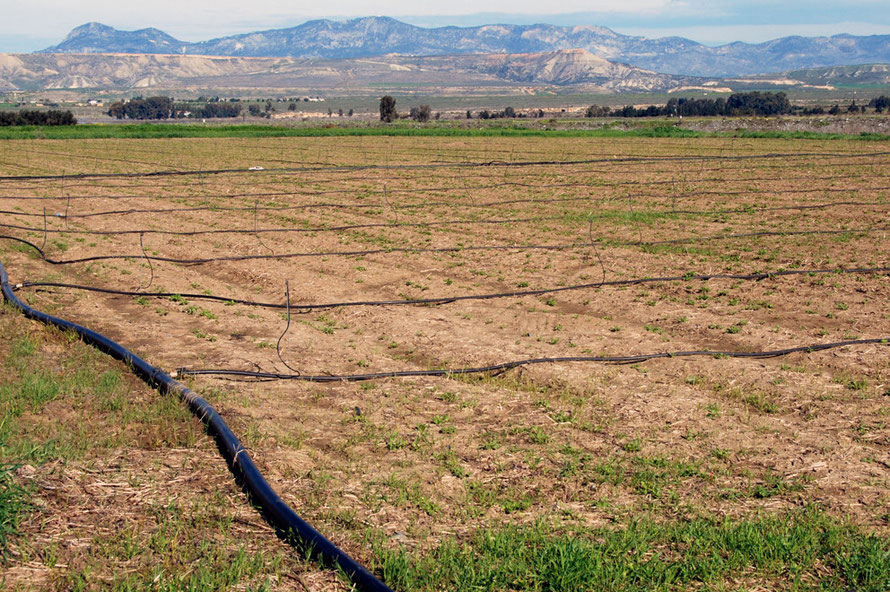
The repeated use of the Peristerona motif of Church and Mosque on bank notes, books and paintings is a potent symbol of an imagined past of the peaceful co-existence of Greek and Turkish Cypriots.
This is a point made by Maria Photiou. She says,
The village of Peristerona is an outstanding example of the two cultures co-existing; a five dome Byzantine church stands next to an Islamic mosque. Both buildings are visible from far away and their image has been imprinted on the five Cypriot pounds banknote and on several book covers and cards reminding us of the past co-existence of Greek-Cypriots and Turkish-Cypriots. Keith Henderson’s (1883-1982) [a Scottish artist - see BBC for images] 'Peristerona' ... represents the artist’s view of the village and probably his beliefs about the two nations.
(see Representations of Cyprus: Impressions of Gender and Culture during British Rule (1878-1959).

I have not been able to locate the elusive 'Peristerona' by Keith Henderson but in searching found the illustration by Henderson for the Empire Marketing Board. (For more on the Empire Marketing Board see this link and for the series of posters, of which only one seems to be about Cyprus, see these pages of the Bridgeman Library of images. For the Empire Marketing Board Film Unit see the BFI.)
And a 2 piatres stamp issued under the British administration in 1938 featuring Peristerona church and the merest hint of the mosque.
The historical decline of Cyprus' mixed villages
The fate of the 'mixed villages' of Cyprus and an assessment of the levels and type of coexistence in them has become the subject of considerable research. It is interesting to look at this area with regard to the village of Peristerona.
In 1891 43 per cent (346 villages) of Cyprus villages were mixed.
Lines of demarcation between the two communities began to change with the Greek revolution of 1821 against the Ottoman empire and was given greater local force when the Ottoman administration executed the island's church leaders, wrongly suspected of supporting the Greek revolution.
The rise of Greek nationalism in Greece and Cyprus and an increasing identification with the idea of a 'Greater Greece' and increasing conflict between Greece and Turkey after WWI coincided with a fall in the percentage of mixed villages to 36% (252) by 1931.
With the rise of the increasingly violent enosis campaign for unification with Greece, and a campaign for a separatist area of Turkish Cyprus, the percentage of mixed villages fell to 18% in 1960. By 1970 this had fallen again to 10% (48).
It is interesting to note that in the 19th century Greek and Turkish Cypriots did not identify themselves as 'Greek' and 'Turkish' but rather as Greek Orthodox and Muslim Cypriots. However, a more salient division than religion may have been that between rich and poor. Many Orthodox and Muslim people were poor. (see Mixed Villages p.11-12 below).
Peter Loizos recounts in his, The Heart Grown Bitter: A Chronicle of Cypriot War Refugees - based on the village of Argaki 10km north west of Peristerona - how social differentiation defined village life. He gives five social classes - i plousii - the rich; i archontes - the people who arrange things; i kali - those who are doing well; i metrii - the middling people; and i phtochi - the poor.
Linguistic divisions were also less in that the lingua franca of Cyprus was a Cypriot dialect - kypriaka - considerably different from its root in mainland Greek. With the rise of anti-Ottoman and later anti-British Greek Nationalism the old language of Cyprus was disparaged and shunned by the advocates of enosis.
(A Cypriot magazine that existed between 1923 and 1937, Kypriaka Chronika, recorded the unique history and language of the island, amongst other things recording folklore sayings only found in Cyprus such as "My fat melts for him" (λυει τον η μιλλα μου), i.e.¨"I genuinely feel very sorry for him".)
It is estimated that between 1963-4 one quarter of the Turkish Cypriot population (20,000) of Cyprus and 200-300 Greek Cypriots were displaced from six villages. In the same period inter-communal violence left 350 Turkish Cypriot and 200 Greek Cypriot dead (for figures see Formerly Mixed Villages in Cyprus: Representations of the Past, Present and Future).
Peristerona as a mixed village
Research shows that in Peristerona the usual order of things in Cyprus was reversed in that the Turkish Cypriot community were the landowners and the Greek Cypriot community provided labour to them in general. However, administrative power was divided equally: each community having its own muhktar (local administator). In addition a bi-communal water committee administered vital irrigation rights from the Peristerona river.
Social interaction was considerable and took place both through professional contacts, personal friendships and around set-piece events such as engagements, weddings and religious festivals. Each community had its own coffee houses but these were not exclusive. The fact that Peristerona did not have areas of housing segregated into distinct communal quarters may have helped here.
In the memory of the Turkish Cypriots of Peristerona trouble came not from the village but from the visiting Greek Cypriots at least up until 1963. After this everything changed and the Turkish Cypriot community was systematically harassed. The Turkish Cypriots of the village remembered this time as one of ‘great sorrow and as one of constant fear’.
‘Neighbours and old friends stopped greeting each other in the street, the presence of strangers in the village was more pronounced, rifle shots were often heard during the night and animals were frequently stolen' (Formerly Mixed Villages above p.44).

This situation led to the mass flight of the Turkish Cypriot community in 1964 and was followed by the looting of their properties by their Greek Cypriot co-villagers.
The research notes that the Greek Cypriot villagers tended to blame the trouble on outsiders whether they be British, EOKA, or the Turkish Cypriot paramilitary group, the TMT, whilst playing down the climate of fear and looting.
Attempts have been made at reconciliation, or at least visits between the displaced Turkish Cypriots and the villagers have taken place, but these are extremely painful and bonds of trust seem to have been completely broken. A small group of people meet up on occassion but its members are gradually dying.
(For above see Association for Historical Dialogue and Research Formerly Mixed Villages in Cyprus: Representations of the Past, Present and Future.)

Peace Research Institute Oslo (PRIO) Cyprus Centre: Internal Displacement in Cyprus - Mapping the consequences of Civil and Military Strife - Census data for Peristerona (1831-2001)
The text in italics below is a direct quote from the PRIO Cyrpus Centre on-line database on Internal Displacement in Cyprus regarding the village of Peristerona
Historical Population:
Peristerona had always been a mixed village. As can be seen from the chart above, in the Ottoman census of 1831, Muslims (Turkish Cypriots) constituted the majority of the inhabitants (56%). However, in 1891 their percentage decreased to 46%. Although the Greek Cypriot population of the village fluctuated in the last decades of the British period, it increased steadily, comparatively better than their Turkish Cypriot neighbors. By the 1960 census the Greek Cypriot share of the village had risen to 59%.
Displacement:
The first recorded conflict-related displacement in relation to Peristerona took place in January 1964. It is known that almost all of the Turkish Cypriot inhabitants of Peristerona fled the village in February 1964, following the killing of two Turkish Cypriot policemen who were stationed in the village.
They moved to more secure Turkish Cypriot-controlled settlements such as the towns of Lefka/Lefke(060) and Nicosia(074) and the villages of Kazivera/Gaziveren(049), Angolemi/Taşpınar(018), Ortakeuy/Ortaköy(080), Krini/Pınarbaşı(235), Elia/Doğancı(029), Limnitis/Yeşilırmak(061) and Fota/Dağyolu(221).
The number of those who were displaced was approximately 500 (as there were 476 Turkish Cypriot inhabitants in 1960). Some went back to the village in 1968, although Richard Patrick recorded only 23 Turkish Cypriots living in Peristerona in 1971.
In 1974, all the Turkish Cypriots who had resettled in Peristerona in 1968 left the village for the north, following the killing of two of their co-villagers by Greek Cypriot irregulars. Currently like many displaced Turkish Cypriots of 1963-64, the Turkish Cypriots of Peristerona are scattered around north Cyprus with a large concentration in Katokopia/Zümrütköy village. There are also many Peristerona Turkish Cypriots settled in the village of Elia/Doğancı and the city of Nicosia.
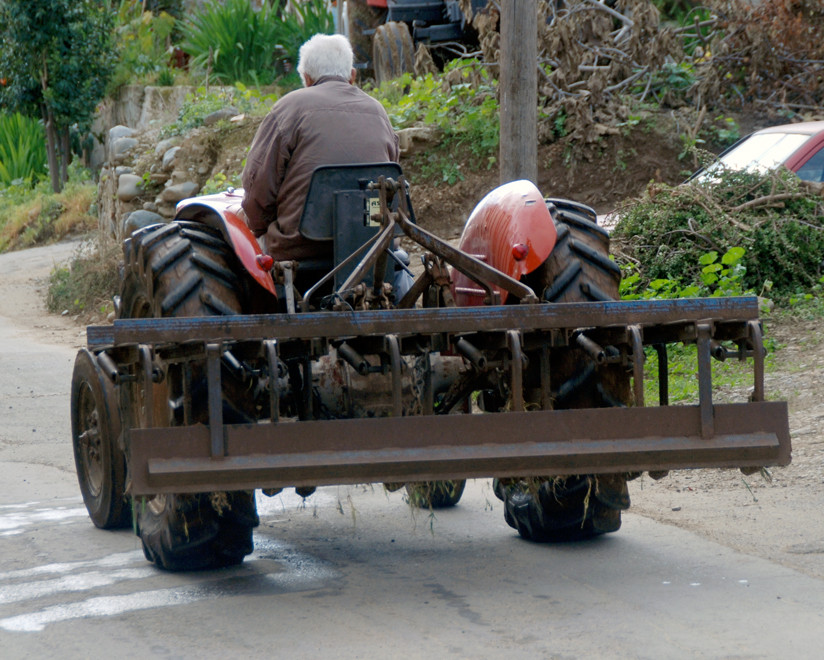
Current Inhabitants:
Currently Peristerona is mainly occupied by its original Greek Cypriot inhabitants and displaced Greek Cypriots from the north. Since 1974, Peristerona has accommodated displaced Greek Cypriots, mainly those from the Morphou area.
Most of the empty Turkish houses were allocated for the use of these displaced Greek Cypriot families. The Peristerona Modern Housing Development was constructed between 1975 and 1982, in six different phases. According to Goodwin, by 1982, there were 500 people living in this development. The last census of 2001 puts the total population of the village at 2,173.

In his Hostage to History: Cyprus from the Ottomans to Kissinger (1989) Christopher Hitchens makes the following point about Peristerona.
In the village ... there is an ugly litter of improvised new buildings. This is not a result of the lust for vulgar development that so disfigures the rest of the Mediterranean. It is the hastily erected shelter for refugees from nearby Greek villages.
Maria Hadjipavlou wrote about the experiences of displaced Cypriots gaining access to the north/south of the island after the opening of crossings on the Green Line in 2003 after 29 years of the complete separation of the Republic and the de facto TRNC in ‘‘I Grow in Different Ways Every Time I Cross’: Multiple Stories: The ‘Crossings’ as Part of Citizens’ Reconciliation Efforts in Cyprus?’’." The Cyprus Conflict: Looking Ahead, 2008: 193-223.
In another instance I witnessed a Turkish Cypriot owner who fled in the 1963 inter-communal violence and went to see his house in Peristerona village in the south. The present owner (a Greek Cypriot refugee) felt uncomfortable and embarrassed living in the real owner’s house.
Greek Cypriot: Do you hate me for living in your house all these years? You can have your house back and I don’t want any money for the changes and repairs I have made….
Turkish Cypriot:. No, I don’t hate you. I also live in a Greek house in Katokopia village (in the north) but unlike you I had no money to make any repairs. I also do not feel that the house [in Katokapia] and the orchard of oranges belong to me although I was given a title by our administration. It is not your fault for what happened but neither was mine. Thank you for taking care of my home and property all these years. You can visit me too. I am ready to give back the keys of the house to the Greek owners. (interview 2004). p.19

In the conclusion of her study Hadjipavlou says,
'The property issue is the most complex and emotional one in the Cyprus conflict because of its connection to identity, justice and family history. This complexity emerged during the ‘crossings.’ This is an example where the same physical space, a home, provides for and symbolizes past and present memories and realities. Each person claims it to be his own. These individuals’ shared personal stories relate to the same piece of land which violence and war deprived it from its legitimate past owner and passed it on to a new occupant. They both experienced dislocation and fear. How can they each come to terms with this mutual loss? Can a judicial process reach a satisfactory settlement?' p.18
She quotes another person, this time a woman, who crossed the line to see her old house:
“A day after our Easter in 2003 I crossed to the other side and visited my house in Lapythos. The Turkish Cypriot woman who has been living in my house invited us in and offered us coffee and not only that, she asked us to stay for lunch. I was emotionally drained. I almost collapsed. Looking at the house I felt so sad: they had not even put a brush of paint on it. It looked so aged. Our orchard was dry, not a drop of water on the trees. They had sold it to some foreign couple to build a villa. How could I bear it? I left feeling sick and weak… could not stand on my own legs…” (Eleni, Greek Cypriot refugee, 2006) p.2.
She also quotes a clinical psychologist who noticed a change that the opening of the Green Line crossings has brought about:
These last few months (2004) the number of my patients has increased. Many suffer from depression and anger after they have seen their houses and properties in the north. Many cannot deal with the fact that someone else is violating their memories and occupies their house. Some have fainted when they saw their house. Others were not able to look at the house and came back. I have prescribed a lot of anti-depressant pills People don’t know how to deal with these feelings. It is a new situation for them. They also feel betrayed by the politicians. I believe we need an institutionalized process for reconciliation and healing. There is a lot of covered-up trauma in Cyprus.” (Despo, Clinical Psycholigist, Greek Cypriot, 2004) (from above p.26)
In his Iron in the Soul: Displacement, Livelihood and Health Volume 23, Forced Migration Peter Loizos concludes that the health of Greek Cypriots forced to flee Argaki did not suffer long-term compared to those who had not been displaced and that life expectancy continued to rise throughout the post-partition period. In this, he concludes, Greek Cypriots fared much better than many in the post-Socialist shocks in Eastern Europe.

The newly restored Peristerona House, pictured above and facing onto the church square, opened in 2010. The Bishop of Morphou, said at the opening, "The aim of the centre is to host events and activities that promote the cultural heritage and civilization of all Cypriots."
“We are convinced that if we wish to live together in one shared homeland, we must work for the creation of a climate of trust, by cultivating in our people a spirit of tolerance, mutual respect,
dialogue, and above all forgiveness” he added (from Cyprus Mail reprinted at Cyprus Directory.)
The restoration process took place between 2007 and 2009 and was funded by the UN Development Programme and US AID's Action for Cooperation and Trust (ACT). The building dates from 1914. US Ambassador to Cyprus, Frank C. Urbanic, said at the opening, "I hope that (Peristerona House's) activities will contribute to building a multicultural and peaceful future."
In an evaluation report on its activities, USAID says it fostered 'the bi-communal alliances needed to complete seven significant cultural heritage restoration projects including ... a community center in the village of Peristerona,'
But a UNDP evaluation suggested the bi-communal alliances created around the restoration had diminished:
However, the Bishopric of Morphou (Peristerona House restoration project - cultural centre) notes that Turkish Cypriot participation in bi-communal activities has recently diminished, for reasons that are not clear. The Cultural Institute of the Bishopric of Morphou, which owns the cultural centre does have committee made up of Greek Cypriot and Turkish Cypriot members, and while they have not met recently, they do keep in regular telephone contract. Nevertheless, the cultural centre is used for many cultural and related activities, which are open to all communities.
Rubin notes in the Rough Guide that the Bishop of Morphou has distinguished himself from his discredited fellow bishops through his 'support for communal reconciliation and by remaining free from scandal (2009: 405).
It seems that Peristerona has been the recipient of considerable EU funding to restore the church square and other buildings (see Cyprus Mail December 13, 2009). A new school was also built.
As a passing tourist I had some intimations about the history of Peristerona. The easy-going homely feel of the village I thought I felt that blissfully sunny day in January may not have been wrong. All that 'history stuff' was a long time ago. But the trauma and wrongs on both sides and the probably greater wrongs of the US, British, Greek and Turkish states continue to resonate 48 years after the 500 Turkish Cypriots of Peristerona were constrained to flee their lives, their land, their friends, their houses and their village.
It is a story that was repeated across Cyprus and given added impetus by the invasion by Turkey in 1974 and the displacement of most Greek Cypriots living in what was to become the de facto TRNC.
But it left a terrible legacy of bitterness and dislocation that continues to reverberate and that must in some way be dealt with if Cyprus is to become, in some way, whole again.
From the little research I have done in looking at the story of Peristerona I get the sense that there are many dedicated people working towards that possibility even if they often seem to be a small minority in an island with many other pressing concerns and ambitions.
I also read recently that in September 2012 three men were arrested and treated for superficial pellet wounds as a result of a massive brawl involving 50 people that took place in the Peristerona (see Cyprus Mail 20 September 2012).
The nationalist party ELAM - who name Greece's Golden Dawn as 'comrades' - claimed that the brawl involved 'foreign nationals' (see Cyprus Mail September 22, 2012 and the ELAM press release September 22 on the Vanguard News Network thread).

And to be even handed ...
There are four villages called Peristerona in Cyprus.
Below is the summary of population displacement in another Peristerona, this time in a 'Peristerona' that is now in the de-facto TRNC and called 'Alaniçi'. This suffered the displacement of its Turkish Cypriot population in 1958 and then its Greek Cypriot population in 1974. It has since been 'resettled' by inhabitants of the TRNC. For details see the PRIO entry in the Internal Displacement in Cyprus database below.
Pigi Peristerona, or Peristerona Piyi, is located between Lefkoniko and Prastrio, and is situated in the Mesaoria plain. Peristerona Pigi consists of two villages, namely Peristerona and Pigi. Peristerona means “pigeon village” in Greek. In Cyprus there are four villages with that name. In 1975, Turkish Cypriots changed its name into Alaniçi, after the village from which most of its current inhabitants derive. Alaniçi is the Turkish alternative name for Klavdia village, located in the Larnaca district.
Historical Population:
Pigi Peristerona was a mixed village until 1958. As can be seen from the chart above, in the Ottoman census of 1831, Muslims (Turkish Cypriots) constituted almost 37% of the population. Approximately ten years after the beginning of the British administration in the island, this number fell to 31%. The Turkish Cypriot population continued to decline in the first half of the 20th century, while the Greek Cypriot population continued to grow. By 1946, after the Second World War, Turkish Cypriots constituted only 8% of the village’s population. By 1960 there were no Turkish Cypriots living in the village.
Displacement:
Due to intercommunal strife, all the approximately 200 Turkish Cypriots were displaced from the village in 1958 and took refuge in Maratha village and the town of Famagusta. None went back to the village in 1960. Turkish Cypriots of the village remained in the nearby village of Maratha(171) and also in the town of Famagusta(140) until the end of 1974, when some returned to Pigi Peristerona while the rest settled permanently in Nicosia and Famagusta.
The second displacement took place in 1974, when all the Greek Cypriots from Pigi Peristerona fled from the advancing Turkish army. Currently the Greek Cypriots of Pigi Peristerona are scattered throughout the island’s south, with small pockets in towns. The number of the Greek Cypriots who were displaced in 1974 was around 1,700.
Current Inhabitants:
Apart from the original Turkish Cypriots of Pigi Peristerona who returned in 1974 and 1975, there are displaced Turkish Cypriots from the island’s south, primarily from the Larnaca area, mainly from Klavdia(359) village. A substantial number of Turkish nationals also settled in the village in the 1970s. In the 1996 Turkish census, 163 out of 719 Turkish Cypriot residents of the village showed their birthplace as Turkey. The 2006 Turkish Cypriot census puts the village’s de jure population at 863.
Text in italics is a direct quote from PRIO Cyprus Centre

















